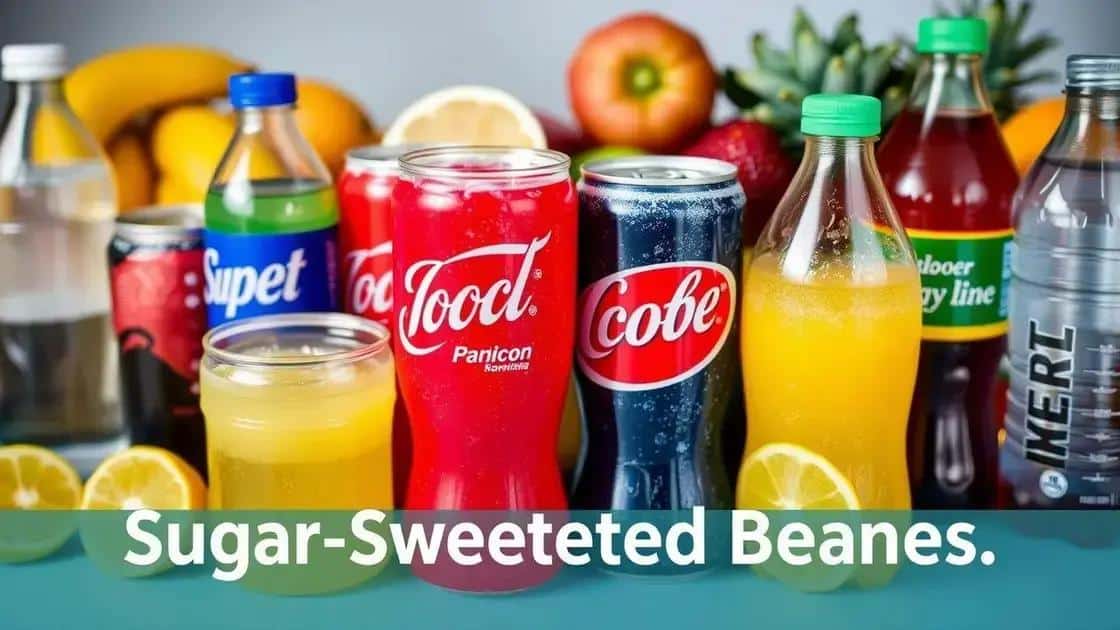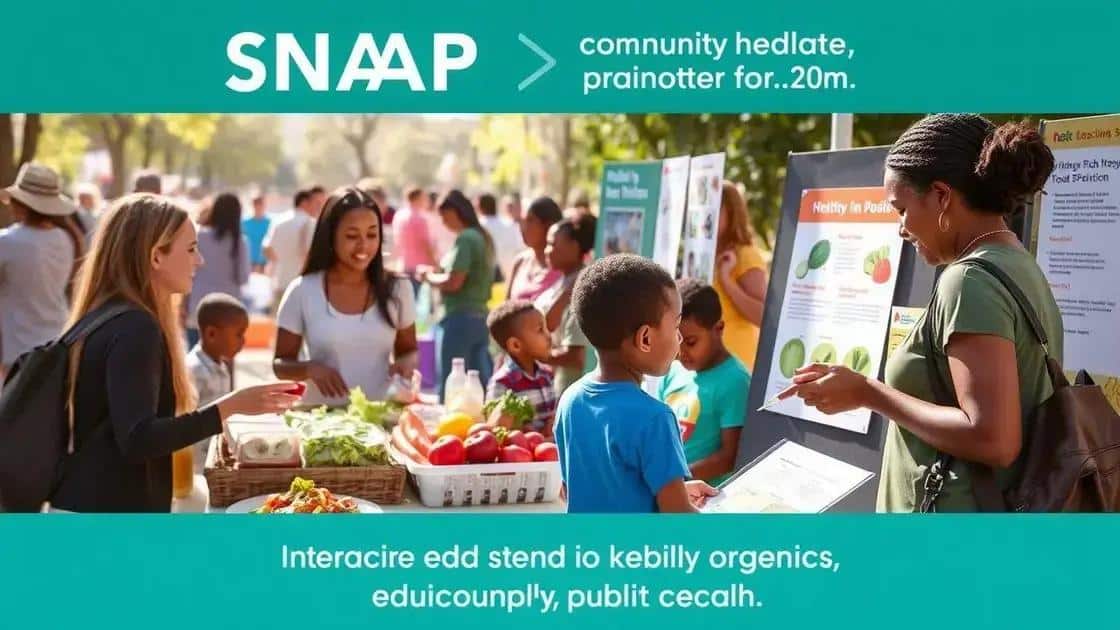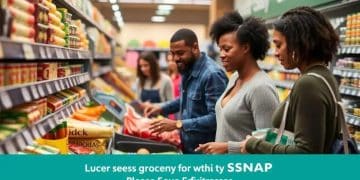SNAP soda and candy ban proposals: what you need to know
Anúncios
The SNAP soda and candy ban proposals aim to improve public health by limiting access to unhealthy food options for low-income families, potentially leading to better nutrition and reduced health risks.
SNAP soda and candy ban proposals are gaining attention as nutrition advocates push for healthier choices in food assistance programs. But how could these changes affect you and your community? Let’s dive deeper into this pressing issue.
Understanding SNAP benefits and restrictions
Understanding SNAP benefits and restrictions is essential for navigating the food assistance landscape. SNAP, or the Supplemental Nutrition Assistance Program, provides vital support to millions of low-income families in the United States.
SNAP benefits come in the form of an Electronic Benefits Transfer (EBT) card, which can be used to purchase eligible food items. However, not all foods qualify for this assistance. This guide will help clarify the key components of SNAP and the various rules governing it.
What Can You Buy with SNAP?
SNAP benefits are intended to help families buy food to maintain a nutritious diet. Eligible items generally include:
-
🍎 Fruits and vegetables
-
🧀 Dairy products
-
🍗 Meats, poultry, and fish
-
🌱 Seeds and plants that produce food
However, there are many restrictions regarding what cannot be purchased with SNAP. These include things like alcoholic beverages, pet food, and prepared meals from restaurants, which can vary by state.
Eligibility Criteria
To qualify for SNAP, households must meet certain income guidelines. Generally, one must prove that their income is at or below the federal poverty line. Eligibility also depends on household size and expenses, such as housing costs. Additionally, some non-citizens may be eligible under specific conditions.
Understanding these regulations is vital for individuals seeking to apply for or currently using SNAP benefits.
Overall, SNAP plays a crucial role in alleviating food insecurity, yet it’s imperative for users to be informed about its benefits and limitations. Grasping the nuances of SNAP benefits can empower families to make informed choices about their food purchases.
The impact of sugar-sweetened beverages

The impact of sugar-sweetened beverages goes beyond just taste; it affects health and nutrition on a large scale. These drinks, which include sodas and energy drinks, are a significant source of added sugars in many diets. Higher consumption of these beverages has been linked to various health issues, making it crucial to understand their effects.
As people consume more sugar-sweetened beverages, they often replace healthier options like water or milk, leading to nutritional imbalances. Regular consumption can contribute to weight gain, as these drinks add extra calories without providing any essential nutrients. Many individuals are unaware that even a single can of soda can have over 150 calories.
Health Risks Associated with Sugar-Sweetened Beverages
Research consistently shows that sugary drinks can lead to increased health risks, such as:
- Obesity: Excessive sugar intake is a leading cause of weight gain.
- Type 2 diabetes: Higher consumption is linked with insulin resistance.
- Heart disease: There is a correlation between sugary drink intake and cardiovascular issues.
- Tooth decay: Sugar promotes bacteria in the mouth that cause cavities.
Despite the known risks, many people still choose these beverages over healthier options. The convenience and marketing of sugar-sweetened drinks often overshadow the potential health impacts, leading to a widespread consumption trend.
Some states and regions are increasingly aware of these challenges. Proposals to restrict sugar-sweetened beverages in public programs like SNAP aim to promote healthier choices. Advocates argue that reducing access to these drinks can lead to better public health outcomes.
Arguments for and against the candy ban
Arguments for and against the candy ban in SNAP are heated and multifaceted. Proponents of the ban believe it can lead to healthier eating habits, especially among low-income families. They argue that implementing restrictions on sugary snacks can reduce the purchase of unhealthy foods and promote better nutrition.
Supporters highlight that candy and sugar-sweetened snacks provide little nutritional value and contribute to obesity. By limiting access to these items, families might be encouraged to opt for more nutritious options, such as fruits and vegetables. This shift could lead to long-term health benefits for recipients and society as a whole.
Benefits of the Candy Ban
Key benefits of instituting a candy ban include:
-
🍏 Reducing childhood obesity rates by limiting access to unhealthy snacks.
-
🥦 Encouraging healthier food choices within low-income households.
-
💰 Potentially decreasing long-term healthcare costs related to diet-related diseases.
-
🌍 Promoting equitable access to healthier food options across communities.
On the other hand, there are strong arguments against the candy ban. Critics assert that such restrictions can undermine personal choice. They argue that families should have the freedom to choose what to buy with their SNAP benefits. Limiting options can feel paternalistic, and some believe it may alienate those who rely on these programs.
Concerns About the Ban
Opponents of the candy ban express several primary concerns:
- The potential stigma associated with using food assistance programs.
- The possibility of decreased morale among SNAP recipients.
- Concerns about who decides what is “healthy” versus “unhealthy”.
- Possible backlash from companies that produce these products, impacting jobs and the economy.
As the debate continues, it is clear that both sides present valid points. The conversation surrounding the SNAP candy ban reveals deeper issues related to health, nutrition, personal freedom, and the role of government in societal wellness.
How SNAP changes affect low-income families

Changes to SNAP can significantly impact low-income families and their ability to access nutritious food. As new policies and restrictions are proposed, it’s crucial to examine how these adjustments affect families who rely on these benefits.
When SNAP benefits are modified, families may find their food choices limited, which can lead to greater food insecurity. For instance, if candy and soda are banned, some families might struggle to adapt to new rules, potentially feeling frustrated about their reduced options.
Impact on Food Security
Food security is a fundamental concern for low-income families. As SNAP changes occur, the ability of these families to maintain a stable and nourishing diet may be compromised. Key points include:
- Families may find it harder to afford healthy options as they adjust to available SNAP foods.
- Restrictions could push families towards cheaper, less nutritious alternatives.
- If budget constraints increase, stress levels may rise across households.
Moreover, changes in SNAP can lead to confusion about what items qualify for purchase. This uncertainty can deter families from shopping efficiently, making grocery trips feel more challenging. Understanding these dynamics is vital, as it can help advocate for more supportive policies.
Challenges of Adapting to Change
Families often face several challenges when SNAP policies shift. Some of these challenges include:
- Learning new guidelines about eligible foods can be overwhelming.
- Adjusting meal planning to comply with new restrictions takes time.
- Loss of familiar products leads to disappointment and frustration.
Overall, it’s important to recognize that SNAP changes not only affect purchasing power but can also influence family dynamics, nutrition, and overall well-being. Supporting families through these transitions is key to promoting food security and health.
Regional variations in SNAP proposals
Regional variations in SNAP proposals highlight how different states address the challenge of food insecurity. Each state has its own approach based on local needs, demographics, and health statistics. This diversity can lead to different rules and benefits for families relying on SNAP.
For example, states with higher obesity rates might focus on limiting sugary drinks and junk food in their SNAP programs. This means that families in those regions may find that certain items are no longer eligible for purchase. Alternatively, other states might advocate for broader access, allowing families to use their benefits on a wider range of food options.
Examples of Regional Differences
Some of the notable regional variations include:
-
🌽 California: This state has initiated programs to encourage farmers’ market purchases. SNAP participants can buy fresh produce with their benefits, promoting better nutrition.
-
🥤 New York: Some proposals in New York aim to ban soda and candy from being purchased with SNAP. These efforts are intended to combat health problems linked to excessive sugar consumption.
-
🤝 Texas: Texas has focused more on expanding eligibility and reducing barriers for immigrant families, allowing more individuals to access support.
-
🍹 Florida: In Florida, there has been discussion about limiting purchases of sweetened beverages, similar to other states, but this proposal has faced significant pushback from residents who prefer maintaining their choices.
These differences reflect local culture, health trends, and political attitudes. While some states push for stricter guidelines, others prioritize accessibility and consumer choice. The ongoing conversation around SNAP changes demonstrates the need for tailored solutions in the fight against food insecurity.
Future outlook for SNAP and public health

The future outlook for SNAP and public health involves various projections tied to ongoing policy changes and societal health trends. As the awareness of nutrition and its impact on health grows, SNAP is increasingly viewed as a key component in supporting public health initiatives.
Several factors will shape the future of SNAP. For instance, rising healthcare costs linked to diet-related diseases emphasize the need for better nutritional support through programs like SNAP. This may lead to more regulations aimed at encouraging healthy food purchases among low-income families.
Potential Changes in SNAP Policies
Future improvements to SNAP could include:
- Increased funding targeted at nutrition education for all recipients, helping families make healthier food choices.
- Implementing stricter guidelines on eligible food items, possibly limiting access to processed foods high in sugar and fat.
- Adding benefits for purchasing fresh fruits and vegetables, similar to programs already in place in some states.
- Expanding access to SNAP for more families, ensuring that vulnerable populations receive assistance.
As the conversations around food access and health evolve, SNAP may also align closer with public health goals. This alignment could result in partnerships between SNAP and health organizations to promote wellness, particularly in underserved communities.
Impact on Public Health Initiatives
With these changes, the potential impact on public health is significant. Improved access to nutritious foods through SNAP can reduce rates of obesity and related diseases. Healthier diets may lead to better outcomes for children and families, contributing to overall wellness.
As the need for holistic food policies increase, SNAP stands as a vital tool in fostering public health. How SNAP evolves will critically affect the food security of millions, shaping not just individual health but community well-being.
Understanding the implications of SNAP soda and candy ban proposals is essential for addressing public health and nutrition. These discussions reveal significant benefits and challenges. On one hand, limiting unhealthy foods could lead to a healthier population, especially among low-income families. On the other hand, it raises concerns about personal choice and the impact on those who depend on SNAP to provide for their families. As SNAP evolves, it continues to play a critical role in combating food insecurity and influencing public health outcomes. The focus should remain on creating a balanced system that fosters healthy choices while respecting individual needs.
FAQ – Frequently Asked Questions about SNAP Soda and Candy Ban Proposals
What are the main goals of the SNAP soda and candy ban proposals?
The main goals are to promote healthier eating habits among low-income families and reduce the consumption of sugary foods that contribute to health issues.
How might these bans affect low-income families?
These bans could limit the types of food low-income families can purchase, potentially affecting their access to healthier food options.
What are some arguments against the candy ban?
Critics argue that the ban limits personal choice, could alienate SNAP users, and raises questions about who decides what is healthy.
How could SNAP evolve in the future to support public health?
SNAP may introduce more nutrition education programs and incentives for purchasing healthy foods, aligning with public health goals.






